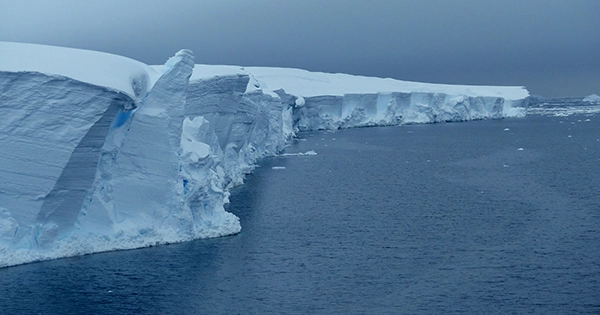A new analysis claims that the Thwaites glacier in Antarctica, also referred to as the “doomsday glacier” due to its high danger of collapsing, is “hanging on today by its fingernails.”
To better comprehend the movements of the Thwaites glacier, a mass of ice on the edge of West Antarctica roughly the size of Florida, marine geophysicists just completed the first-ever high-resolution survey of the seafloor in front of it.
According to the latest research, the glacier’s base detached from the seafloor at some time in the past 200 years, and over the course of six months, it receded at a rate of 2.1 kilometers (1.3 miles) each year. That is twice the rate that has been observed using satellites during the past ten or so years.
This week, the study was published in the journal Nature GeoSciences.
The conventional wisdom that Antarctic glaciers adapt to change slowly is called into question by this observation. It seems that the Thwaites glacier may be far more prone to fast retreats than previously believed once we factor in the additional threat of climate change. Similar quick retreat pulses “are expected to occur in the near future,” according to the report.
Alastair Graham, a primary study author from the University of South Florida’s College of Marine Science, stated in a statement that “our data show that pulses of very rapid retreat have occurred at Thwaites Glacier in the last two centuries, and probably as recently as the mid-20th Century.”
He continued, “Just a little kick to Thwaites may cause a major reaction.
The Thwaites glacier, which holds back enough ice to increase sea level by up to a meter, is popularly known as the “doomsday glacier” (over 3 feet). Sea level rise could be seriously impacted if it completely collapses through a quick retreat.
This important body of ice is in a concerning state, according to numerous recent studies. A study published in 2020 asserted that the Thwaites glacier appeared to be growing more unstable as it recede. According to a 2021 prediction, the glacier will likely disintegrate in just five years.
This most recent study emphasizes that the glacier has historically seen rapid retreats, and we should expect to see a lot of the same in the years to come.
Robert Larter, a marine geophysicist and study co-author from the British Antarctic Survey, said, “Thwaites is really hanging on by its fingernails today. We should expect to see big changes over small timescales in the future – even from one year to the next – once the glacier retreats beyond a shallow ridge in its bed.













